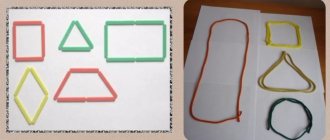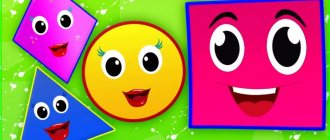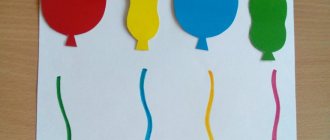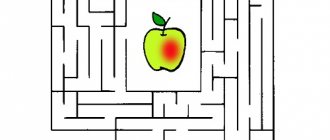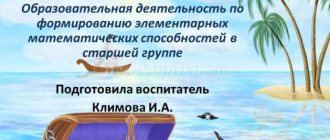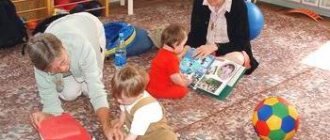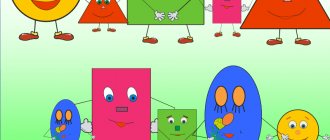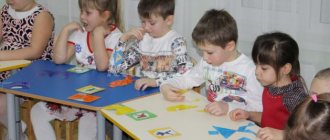Summary of a lesson on the formation of elementary mathematical concepts on the topic: “Oval”
Attached to each carriage is a card with a picture made up of geometric shapes drawn on the tickets:
— I am a cashier at a railway ticket office. Each of you will receive a ticket. Then you need to find your carriage. To do this, take a close look at your tickets. If you find the same geometric shapes on the carriage, then this carriage is yours.
While the children are looking for their seats, the teacher takes on the role of conductor (puts on a cap, takes a bag, attaches a badge). The children get into their carriages.
— Has everyone taken their seats? (Yes).
- Now I am a conductor. Show your tickets.
The teacher checks the “tickets”.
Subtotal:
Well done guys, everyone managed to get on the train because they correctly identified the geometric shapes. We can go.
The audio recording “Knock of Wheels” is played.
- Guys, we've arrived!
3. Difficulty in a game situation.
Goal: organizing an analysis by children of the situation that has arisen, leading them to identify the location and cause of the difficulty.
Requirements:
- creating a situation of difficulty;
- fixation in speech of the cause of the difficulty.
Children are “met” by the inhabitants of the country of Geometric shapes (triangle and square). Under the magnet next to them is a piece of paper with a task.
— Guys, do you think the inhabitants of the country of Geometric Shapes are happy to see us? (Yes).
- How did you guess? (They smile at us).
- Of course, the residents are happy, because you came to help them!
- Let's ask the residents how to help them! (The children ask, but the circle and square are silent).
- Learned? (No)
— How do you know how to help residents? (Guess), (See for yourself what needs to be done), (Read what is written in the note).
The teacher reads the note:
“Put things back where they belong, in boxes.”
Game "Putting objects in place"
The children sit at the tables. On the tables there is a “box” (a large circle) and “things” - round-shaped objects: a wheel, a watch, a plate, a coin, a tray, a sponge, a steering wheel, cookies, a steering wheel, a CD, a cutting board, a lifebuoy. The size of the small circles is such that they fit into an oval. There are also oval-shaped objects according to the number of children - a watch, a mirror, a piece of bread, a tray, a plate, a sponge, a napkin, a wooden cutting board, a plastic cutting board, a rug.
— What shape is the box? (Round).
- This means that round objects must be put in it.
— Put these items in the box. (the teacher points to a circle cut out of a landscape paper)
Children place round objects in a circle, but cannot place oval objects.
— Are all things in place now? (No).
—You couldn’t put all your things away? (Failed).
- Why? What's the problem? (There are things that are not round, the mirror does not fit into the box).
- Why can't we put these things in a round box? (Because it is of a different shape; the napkin is not round).
“You couldn’t remove all the things and help the residents.”
The teacher pauses long enough for the children to comprehend the situation of difficulty.
—Are you in a difficult situation? (Yes).
- Discovery of new knowledge.
Goal: organizing a dialogue between the teacher and children aimed at discovering new knowledge.
Requirements:
- organizing an introductory dialogue in order to discover new knowledge;
- fixation of new knowledge in speech and symbolically;
- creating a situation of success.
Game "Find the box"
- What do we do? (Let's pick a box for these items).
If the children find it difficult, the teacher continues the introductory dialogue:
— You put round objects in a round box. Items that you were unable to remove have a different shape. Can you find a suitable box for it? (Yes).
- Pick it up.
Children go to another table, on which there are squares, triangles, circles and ovals cut out of colored cardboard. There are as many ovals as there are children.
— Guys, choose a suitable box and put the items in it.
Children choose the desired “box” and sit down.
— Now all the items are put away in boxes? (Yes).
- Count how many round objects you have? (Four).
— How many non-round objects do you have? (One).
Subtotal:
Well done, you managed to tidy up because you picked suitable boxes for both round and oval items.
The teacher tells the children that the inhabitants of the country of Geometry thank them and give them a gift - a box with ovals. Children each take an oval,
The teacher hangs an oval on the board.
- Do you want to play with them? (Yes)
- Look at the oval.
- Circle it with your finger (children circle the oval).
-What did you notice? (an oval has no corners)
- What other figure does not have corners? (at the circle)
— How does an oval differ from a circle (an oval is elongated, and a circle is smooth)
We know that the circle rolls well (the teacher shows how the circle rolls)
— Try to roll an oval (children roll an oval).
— The oval also rolls well (no).
- Let's hide the oval (children “hide” the oval under a sheet of paper)
The teacher shows the ellipsoid.
- Is this an oval? (Not really)
- Let's try to hide it (the children are trying to hide the ellipsoid under a sheet of paper).
— Did you manage to hide this figure? (No)
- That's right, this figure is not an oval, an oval is flat.
The teacher points to the oval.
- Here is an oval - it is flat, elongated, without corners.
Summary: Well done guys, you understand what an oval is.
5. Inclusion of new knowledge into the knowledge system.
Goal: consolidate new knowledge in children through games and exercises.
Requirements:
- compliance of the games used with the purpose of the lesson;
- individual difficulties in games;
- situation of success in joint activities.
A rectangle appears with a sad face on it. He has a note.
— Another resident came to us. What do you think is his mood? (he is sad, cheerless)
- Ask why he is so sad?
- Why are you so sad?
(The children ask, but the rectangle is silent.)
- Learned? (No)
- How to find out? (Guess, read what is written in the note).
The teacher reads the note:
“I lost oval objects because I was lazy and didn’t put them back in their place.”
- Don’t worry about the rectangle, our guys will help you.
- Guys, can you help? (Yes)
Game "Collect objects"
The teacher is holding an oval-shaped box in his hands.
- Look carefully around, find all the oval-shaped objects in our group and bring them to this box.
Children look for oval objects laid out everywhere in a group (mirror, rug, sponge, napkin, etc.)
Subtotal:
Well done boys. You completed the task and found all the lost oval objects.
When children find all the oval objects, they give the box to the rectangle. The rectangle has a joyful face. He has a note.
- Look, guys, another note. Let's read it.
The teacher reads the note:
"Thank you guys. I will never throw my things around again. Because you helped me, I want to give you a cartoon.”
Children watch the cartoon "Geometric Shapes".
— Guys, did you like the rectangle gift? (Yes)
“Now it’s time for us to go back to kindergarten.” Take your seats on the train.
The sound of wheels sounds in the recording, the children return to kindergarten.
- Summary of the lesson.
Goal: organizing reflection and self-assessment of children’s activities.
Requirements:
- organization of analysis of children's goals;
- fixation of new knowledge in speech;
- determining the fulfillment of an adult goal.
Children sit on chairs.
- Guys, where were we today? (in the country of Geometry)
- Why did we go there? (help residents clean up)
— Were we able to help the inhabitants of the country of Geometry? (Yes)
- Why did you succeed? (we know geometric shapes, we know colors, we can count, we are kind)
- What geometric shape did we meet today? (oval)
“We completed all the tasks because we know geometric shapes, we know colors, we can count, because we are attentive, kind guys. Well done!
Summary of the lesson on FEMP in the middle group “Visiting geometric figures”
I have no corners, And I look like a saucer. For a medal, for a pancake, for an aspen leaf. Think, friends, and tell me, who am I? (Circle) *** My three sides can be of different lengths. Where the sides meet - The angle is obtained. What happened? Look! After all, there are also three corners. Look at me, say my name. (Triangle) ***You can't roll him into the goal like a ball.
And he won’t start galloping after you.
Four corners and four sides
Similar, just like sisters,
The figure is familiar to many guys.
Did you recognize him? After all, this is... (Square)
Children solve riddles and show geometric shapes (Dyenesha blocks).
Educator: Friends lived in a cozy house (a house appears on the interactive board), what shape were the walls of this house, its roof, its window? (children's answers) Friends often sat on chairs with comfortable ... (square) seats. They had a table...(round). When setting the table, friends put ... (round) plates. They put...(square) pieces of sugar in the tea. Friends really loved... (triangular) cookies. One day someone knocked on the door of their house. Friends came out onto the threshold and saw: standing in front of them was an amazing figure, a little like a circle. (an oval appears on the board). We started getting acquainted.
Educator: Hello friends! My name is Oval, I'm shaped like a circle, look. (the teacher puts an oval next to the circle, puts the circle on the oval, the children highlight the similarities and differences of the figures).
Educator. Children, name objects that are shaped like an oval (children’s answers).
Oval. Let me live with you.
Educator. The figures agreed and they began to live together. Every morning they went outside and did exercises. And how they did it, I’ll show you now.
Children get up from their chairs and do physical education exercises.
Once - bend over, straighten up,
Two - bend over, stretch,
Three claps, three claps, three nods.
Four - arms wider,
Five and six - sit down quietly.
Educator. So one day they decided to go for a walk with a circle, a square and a triangle and an oval. The prankster oval ran away from his friends and hid in the garden (the teacher puts in front of the children a poster “garden” on which there are images of vegetables). The friends looked around, there was no oval, they began to look for it. They search and search, but they can’t find it. Children, help the figures find the oval. To do this, choose vegetables that resemble an oval in shape (children choose cucumber, eggplant, zucchini...) Among the vegetables, friends found an oval. They moved on. After some time, a dense forest stood in their way. Animals came out from behind the trees. Guess which ones?
Children name them and list the geometric shapes from which the images are made. (task cards where you need to lay out animals using Dienesh blocks)
Teacher (addresses the children): Lyosha, what geometric shapes do you see in the image of a fox?...a bear?...a hare?
Educator. Circle, Oval, Square Triangle met the forest inhabitants and decided to take their portraits as a souvenir.
Children sit at tables and, using sample diagrams and Dienesh blocks, lay out images of animals.
Educator. We said goodbye to the circle, square, triangle and oval with the forest inhabitants and went for a walk in the forest (the children walk through the music hall to quiet music). They walked for a long time or a short time, but now it’s time to return home (the children sit on chairs, the teacher puts the geometric figures in their original place near the house).
Reflective moment.
Educator. Well guys, our fairy tale is over. The time has come for us to return to kindergarten. Did you enjoy the cinema? What new things did you learn today, what (who) did you meet? I also liked you today: you listened carefully and quickly answered questions.
Recommendations for parents:
1. Play didactic games with the children: “Find an oval-shaped object” (invite the children to find oval-shaped objects in the environment); “What does it look like” (show the children an oval and invite the children to think and name what it looks like, for example, the body of an animal, a balloon...).
Lesson on FMP in the middle group on the topic “Introduction to the number 2. Short, long, oval.”
Summary of an open lesson on FEMP in the middle group on the topic “Introduction to the number 2. Short, long, oval.”
Program content: Introduce children to the number 2; learn to determine the position of the number 2 among the number line; consolidate the ability to find number 2 among other numbers; consolidate the ability to compare familiar objects by size, length (long, short); consolidate knowledge about the geometric figure “oval”, the ability to find it among many figures; cultivate a sense of mutual assistance and accuracy. Equipment and materials: toys - camel and baby camel, workbook No. 1. Preliminary work: while walking, collect bouquets of two leaves, play the game “On a narrow path.” Vocabulary work: short, long, oval. Bilingual component: eki-two, t?ye – camel, sopa?sha – oval. Progress of the lesson: A surprise moment. A baby camel came to visit. He lost his mother, but if the guys guess the riddles, then the camel’s mother will definitely come for the baby camel.
I'm asking a riddle:
“A camel walks in the steppe. How sad it is to be alone on the road But his son came up to him And he is no longer alone.” I invite the children to complete a task in their workbook: fill in as many circles in the rectangle under the picture as there are camels walking in the steppe. I ask how many circles were painted in? A camel appears, takes the baby camel, and they leave. I read a poem to the children about the number two: “The two arches its neck, lets its tail go. How can she not swim on the waves, But she can always be second!” Let's memorize a poem. Are we working in workbooks? Children determine the place of the number on the number line, find all the twos among the other numbers and circle them, as shown in the figure. I’m conducting physical education “Maple”. The wind quietly shakes the maple tree, tilts left and right, tilt once and tilt twice. The maple leaves rustled. I invite the children to work in workbooks. Color the largest oval with a green pencil, the smaller one with blue, and the smallest one with red. I ask: how many ovals were painted over? what size are the ovals? I read a poem: On a very hot summer day.
The camel was going to water.
Help him quickly
Get to the water faster.
Don't waste your time,
And choose the road. I give the task to paint the long road yellow, and the short road green. I ask questions: how long is the yellow road? how long is the greenway? Which road will the camel get there faster? I do individual work. We repeat the words in the Kazakh language. We carry out self-monitoring and self-assessment of the work performed. Reflection: what did you like about the lesson? How many ovals did you paint?
